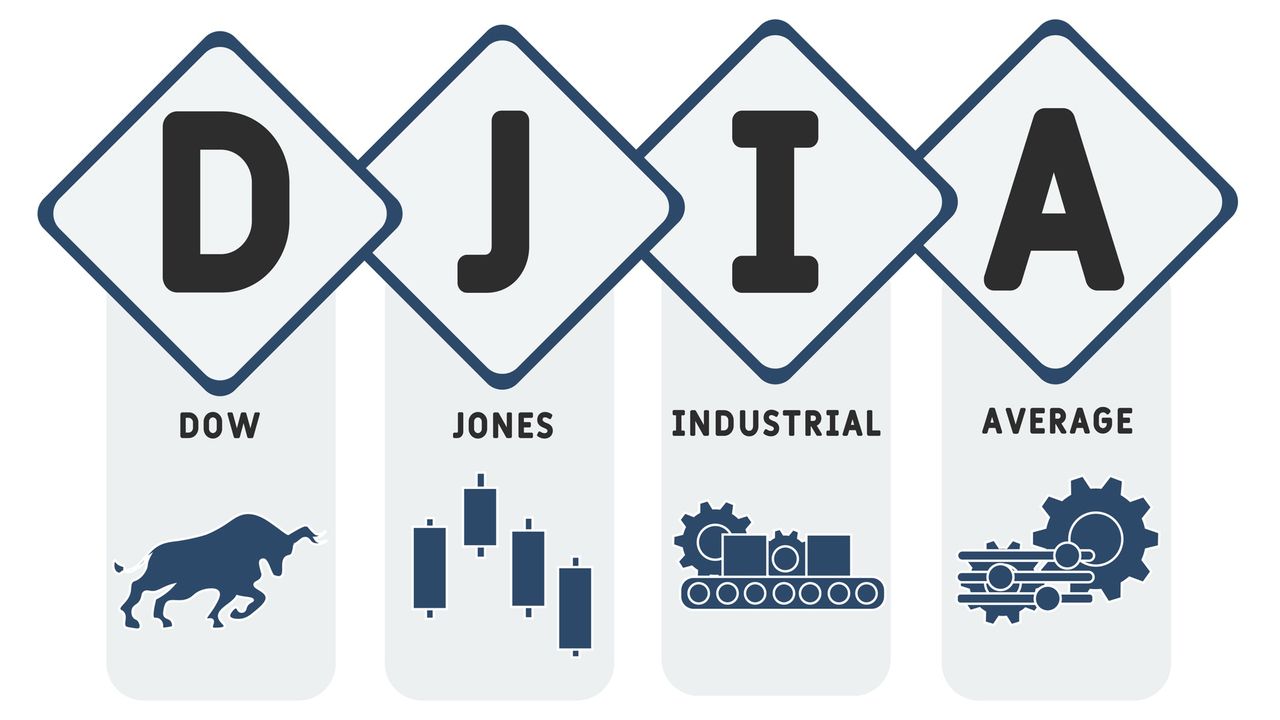All 30 Dow Jones Stocks Ranked: Buy, Sell or Hold?
UnitedHealth Group, Nvidia and Amazon.com are Wall Street's top Dow Jones stock to buy now. Some other names might surprise you.


You can't beat Dow Jones stocks for stability and defense in a down market. By the same token, the blue chip average won't always keep up in a rising market.
Case in point: the broader S&P 500 added about 22% on a price basis over the past year through the early days of February, while the "growthier" tech-heavy Nasdaq Composite gained 26%. The Dow Jones Industrial Average, by comparison, very much lagged the pack. The elite bastion of 30 mostly more mature industry leaders delivered comparatively poky upside of less than 16%.
You can blame the Magnificent 7 stocks for much of the Dow's underperformance. Of the mega-cap tech stocks driving the majority of the bull market's returns this year, only Microsoft (MSFT), Apple (AAPL) and Amazon.com (AMZN) could be found in the blue-chip average until mid-November. Replacing buy-and-hold bust Intel (INTC) with Nvidia (NVDA) should certainly help the Dow going forward. The fact that the Dow is weighted by price rather than market cap is another reason it's lagging the other main benchmarks.
The current state of concentrated returns notwithstanding, it's important to know the Dow's recent underperformance isn't all that abnormal. Half of the average's components are low-beta stocks. That means they tend to lag in up markets, but hold up better when everything is selling off. This low-beta skew can actually be quite advantageous to long-term investors.
After all, as bright a time as it's been for equity investors, downside risks very much remain. The new administration's regulatory and trade agendas look to be pro-growth, but could also help stoke a resurgence in inflation. As such, market participants eager for interest rate cuts have had to scale back their expectations.
Meanwhile, although recession fears have eased greatly, surveys of economists put the odds of recession hitting in the next year at about 26%. The New York Fed's yield-curve model assigns a similar probability to the U.S. entering a recession over the next 12 months.
Should such a change in market fortunes come to pass ... well, that's where Dow Jones stocks come in.
Dow Jones stocks ranked
This collection of industry-leading companies and dividend growth stalwarts with their fortress-like balance sheets can offer relative stability in tempestuous market times. From the best Dow dividend stocks to the most widely held blue chip stocks, components of the industrial average occupy top spots in the portfolios of hedge funds and billionaire investors. Warren Buffett's Berkshire Hathaway (BRK.B), in particular, is a huge fan of select Dow stocks.
To get a sense of which Dow Jones stocks Wall Street recommends at an increasingly uncertain time for equities, we screened the DJIA by analysts' consensus recommendations, from worst to first, using data from S&P Global Market Intelligence.
Here's how the ratings system works: S&P surveys analysts' stock calls and scores them on a five-point scale, where 1.0 equals a Strong Buy and 5.0 is a Strong Sell. Scores between 3.5 and 2.5 translate into Hold recommendations. Scores higher than 3.5 equate to Sell ratings, while scores equal to or below 2.5 mean that analysts, on average, rate shares at Buy. The closer a score gets to 1.0, the higher conviction the Buy recommendation.
In other words, lower scores are better than higher scores.
Please note that Nvidia replaced INTC in the gauge in November, while paint maker Sherwin-Williams (SHW) was swapped in for chemicals company Dow (DOW). Amazon.com (AMZN) was added to the Dow in February 2024, replacing Walgreens Boots Alliance (WBA).
See the table below for analysts' consensus recommendations on all 30 Dow Jones stocks, per S&P Global Market Intelligence, as of February 5, 2025.
You can't beat Dow Jones stocks for stability and defense in a down market. By the same token, the blue chip average won't always keep up in a rising market.
Case in point: the broader S&P 500 added about 22% on a price basis over the past year through the early days of February, while the "growthier" tech-heavy Nasdaq Composite gained 26%. The Dow Jones Industrial Average, by comparison, very much lagged the pack. The elite bastion of 30 mostly more mature industry leaders delivered comparatively poky upside of less than 16%.
You can blame the Magnificent 7 stocks for much of the Dow's underperformance. Of the mega-cap tech stocks driving the majority of the bull market's returns this year, only Microsoft (MSFT), Apple (AAPL) and Amazon.com (AMZN) could be found in the blue-chip average until mid-November. Replacing buy-and-hold bust Intel (INTC) with Nvidia (NVDA) should certainly help the Dow going forward. The fact that the Dow is weighted by price rather than market cap is another reason it's lagging the other main benchmarks.
The current state of concentrated returns notwithstanding, it's important to know the Dow's recent underperformance isn't all that abnormal. Half of the average's components are low-beta stocks. That means they tend to lag in up markets, but hold up better when everything is selling off. This low-beta skew can actually be quite advantageous to long-term investors.
After all, as bright a time as it's been for equity investors, downside risks very much remain. The new administration's regulatory and trade agendas look to be pro-growth, but could also help stoke a resurgence in inflation. As such, market participants eager for interest rate cuts have had to scale back their expectations.
Meanwhile, although recession fears have eased greatly, surveys of economists put the odds of recession hitting in the next year at about 26%. The New York Fed's yield-curve model assigns a similar probability to the U.S. entering a recession over the next 12 months.
Should such a change in market fortunes come to pass ... well, that's where Dow Jones stocks come in.
Dow Jones stocks ranked
This collection of industry-leading companies and dividend growth stalwarts with their fortress-like balance sheets can offer relative stability in tempestuous market times. From the best Dow dividend stocks to the most widely held blue chip stocks, components of the industrial average occupy top spots in the portfolios of hedge funds and billionaire investors. Warren Buffett's Berkshire Hathaway (BRK.B), in particular, is a huge fan of select Dow stocks.
To get a sense of which Dow Jones stocks Wall Street recommends at an increasingly uncertain time for equities, we screened the DJIA by analysts' consensus recommendations, from worst to first, using data from S&P Global Market Intelligence.
Here's how the ratings system works: S&P surveys analysts' stock calls and scores them on a five-point scale, where 1.0 equals a Strong Buy and 5.0 is a Strong Sell. Scores between 3.5 and 2.5 translate into Hold recommendations. Scores higher than 3.5 equate to Sell ratings, while scores equal to or below 2.5 mean that analysts, on average, rate shares at Buy. The closer a score gets to 1.0, the higher conviction the Buy recommendation.
In other words, lower scores are better than higher scores.
Please note that Nvidia replaced INTC in the gauge in November, while paint maker Sherwin-Williams (SHW) was swapped in for chemicals company Dow (DOW). Amazon.com (AMZN) was added to the Dow in February 2024, replacing Walgreens Boots Alliance (WBA).
See the table below for analysts' consensus recommendations on all 30 Dow Jones stocks, per S&P Global Market Intelligence, as of February 5, 2025.
Company (Ticker) | Analysts' Consensus Recommendation Score | Analysts' Consensus Recommendation |
|---|---|---|
American Express (AXP) | 2.72 | Hold |
Travelers (TRV) | 2.68 | Hold |
Caterpillar (CAT) | 2.59 | Hold |
International Business Machines (IBM) | 2.50 | Buy |
Amgen (AMGN) | 2.43 | Buy |
Verizon Communications (VZ) | 2.28 | Buy |
Honeywell International (HON) | 2.27 | Buy |
JPMorgan Chase (JPM) | 2.26 | Buy |
Cisco Systems (CSCO) | 2.21 | Buy |
Johnson & Johnson (JNJ) | 2.18 | Buy |
Nike (NKE) | 2.18 | Buy |
Goldman Sachs (GS) | 2.17 | Buy |
Sherwin-Williams Company (SHW) | 2.17 | Buy |
3M (MMM) | 2.16 | Buy |
Boeing (BA) | 2.07 | Buy |
Apple (AAPL) | 2.07 | Buy |
Procter & Gamble (PG) | 1.96 | Buy |
Chevron (CVX) | 1.96 | Buy |
Walt Disney (DIS) | 1.94 | Buy |
Home Depot (HD) | 1.93 | Buy |
McDonald's (MCD) | 1.92 | Buy |
Salesforce (CRM) | 1.80 | Buy |
Merck (MRK) | 1.73 | Buy |
Coca-Cola (KO) | 1.73 | Buy |
Visa (V) | 1.68 | Buy |
Walmart (WMT) | 1.55 | Buy |
Microsoft (MSFT) | 1.42 | Strong Buy |
Amazon.com (AMZN) | 1.41 | Strong Buy |
Nvidia (NVDA) | 1.32 | Strong Buy |
UnitedHealth Group (UNH) | 1.30 | Strong Buy |
Related Content
Get Kiplinger Today newsletter — free
Profit and prosper with the best of Kiplinger's advice on investing, taxes, retirement, personal finance and much more. Delivered daily. Enter your email in the box and click Sign Me Up.

Dan Burrows is Kiplinger's senior investing writer, having joined the august publication full time in 2016.
A long-time financial journalist, Dan is a veteran of SmartMoney, MarketWatch, CBS MoneyWatch, InvestorPlace and DailyFinance. He has written for The Wall Street Journal, Bloomberg, Consumer Reports, Senior Executive and Boston magazine, and his stories have appeared in the New York Daily News, the San Jose Mercury News and Investor's Business Daily, among other publications. As a senior writer at AOL's DailyFinance, Dan reported market news from the floor of the New York Stock Exchange and hosted a weekly video segment on equities.
Once upon a time – before his days as a financial reporter and assistant financial editor at legendary fashion trade paper Women's Wear Daily – Dan worked for Spy magazine, scribbled away at Time Inc. and contributed to Maxim magazine back when lad mags were a thing. He's also written for Esquire magazine's Dubious Achievements Awards.
In his current role at Kiplinger, Dan writes about equities, fixed income, currencies, commodities, funds, macroeconomics, demographics, real estate, cost of living indexes and more.
Dan holds a bachelor's degree from Oberlin College and a master's degree from Columbia University.
Disclosure: Dan does not trade stocks or other securities. Rather, he dollar-cost averages into cheap funds and index funds and holds them forever in tax-advantaged accounts.
-
 RMD Deadline April 1: Five Tax Strategies to Manage Your 2025 Income
RMD Deadline April 1: Five Tax Strategies to Manage Your 2025 IncomeTaxable Income The April 1, 2025, deadline for required minimum distributions (RMDs) is fast approaching for retirees who turned 73 in 2024.
By Kelley R. Taylor Published
-
 Rising AI Demand Stokes Undersea Investments
Rising AI Demand Stokes Undersea InvestmentsThe Kiplinger Letter As demand soars for AI, there’s a need to transport huge amounts of data across oceans. Tech giants have big plans for new submarine cables, including the longest ever.
By John Miley Published
-
 How Much Does Being Rich Matter in Retirement?
How Much Does Being Rich Matter in Retirement?After a certain point, having more money in retirement won't make you any happier, new research shows. Instead, physical health, a sense of purpose, and a minimal amount of non-mortgage debt are more relevant.
By Christy Bieber Published
-
 The Three Biggest Fears Keeping Retirees Up at Night
The Three Biggest Fears Keeping Retirees Up at NightHere are the steps you can take to put those fears to rest and retire with confidence so you can relax and enjoy the life you've planned.
By Pam Krueger Published
-
 What Can a Donor-Advised Fund Do for You? (A Lot)
What Can a Donor-Advised Fund Do for You? (A Lot)DAFs and private foundations go about helping charities (and those who donate) in different ways. Each comes with its own benefits and restrictions to navigate.
By Julia Chu Published
-
 Estate Planning When You Have International Assets
Estate Planning When You Have International AssetsEstate planning gets tricky when you have assets and/or beneficiaries outside the U.S. To avoid costly inheritance mistakes, it pays to understand the basics.
By Kelsey M. Simasko, Esq. Published
-
 Microsoft Stock: Innovation Spurs Its 100,000% Return
Microsoft Stock: Innovation Spurs Its 100,000% ReturnMicrosoft's ability to recognize the "next big thing" has allowed sales – and its share price – to grow exponentially over the years.
By Louis Navellier Published
-
 Three Essential Estate Planning Steps to Protect Your Nest Egg
Three Essential Estate Planning Steps to Protect Your Nest EggAfter dedicating years to building your wealth and securing your future, make sure your assets are protected and your loved ones are provided for in the future.
By Nicole Farbo, CFP® Published
-
 Is Chasing the American Dream Ruining Your Financial Life?
Is Chasing the American Dream Ruining Your Financial Life?Too many people focus on visible affluence as a marker of success. Here's how to avoid succumbing to the pressure and driving yourself into debt.
By Anthony Martin Published
-
 Stock Market Today: Dow Sinks 715 Points as Inflation Unrest Grows
Stock Market Today: Dow Sinks 715 Points as Inflation Unrest GrowsInflation worries are showing up in both hard and soft data.
By Karee Venema Published
